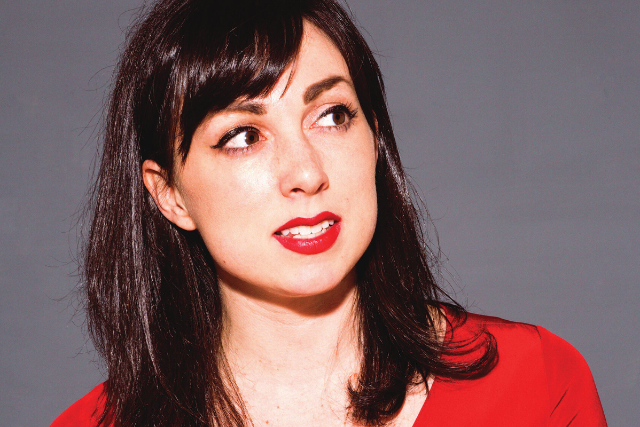Erin Ryan is among the quickest, funniest people I know. We once worked one desk over from each other at the blog sweatshop that was early 2010s Gawker Media, her at Jezebel and me at Gizmodo. She moved on to write for the Daily Beast and It’s Always Sunny In Philadelphia, among others. Most recently, she’s been the lead host of the massively popular Hysteria podcast. You might think it’s as simple as throwing a bunch of smart, funny people in a room together and letting them loose, but there’s far more to it than meets the eye.
Ryan and I jumped on a call recently to talk about the show’s beginnings, how it’s evolved, and how it continues to stay fresh. This conversation has been edited for length and clarity.
The reverse pitch
Once upon a time, way back in 2016, Erin Ryan was writing a piece for the Daily Beast about the origins of the phrase “dumpster fire,” as one does. For it, she interviewed a bunch of people in politics and in the media, including commentators Jon Favreau and Tommy Vietor. The three hit it off and ended up staying connected on social media. In early 2017, Favreau, Vietor, and Jon Lovett took their podcast Keepin’ it 1600 from The Ringer network and started their own network, Crooked Media. When their new podcast—the juggernaut that is Pod Save America— debuted their first guest was Erin Ryan. In fact, she was on the week before President Obama was a guest. Ryan was notorious for her scathing and hilarious political commentary (in articles as well as on Twitter), and it was a perfect fit.

Later that summer, Ryan visited Los Angeles (where she now lives) and was set to meet Lovett for coffee, but all three of the Crooked Media gang showed up. They then pitched her on hosting her own show on their network, and effectively told her the show could be whatever she wanted. They put her in touch with Corinne Gilliard, who was in charge of podcast development at Crooked, and they began to bat ideas around. Early on, Ryan decided she wanted it to be focused on women’s voices.
Clarifying the concept
“There’s a specific feeling that you get when you’re at brunch or you’re at drinks or reading a book at a cafe, and you’re sitting next to a table of people that are having a really smart conversation and you just get to observe it without interfering with it,” Ryan tells me. That was the kind of atmosphere she wanted to create. Then she remembered reading an article about the way that single-sex education works for boys versus girls. “Girls who are only around other girls when they’re growing up raise their hand more, and they’re more likely to chime in in class. Then, when there’s a boy present—it doesn’t matter if it’s a ‘good boy’ or ‘a jerk’—they speak up less,” she says. “And I thought, you know, I think a lot of women—and men—could stand to hear a conversation between women that’s completely unsullied by men. Not that men are conversation-sulliers, but there’s something very special about the way that women talk to each other when it’s just us.”
That was the a-ha moment. The show could let the audience eavesdrop on a conversation between smart, funny, women who like and respect each other. Hysteria became a massive hit right out of the gates, soaring to the #1 spot on iTunes’ most popular podcasts and racking up a million downloads within just a few months.
A podcaster prepares
Putting the show together was a slow, protracted process filled with behind-the-scenes trial and error.
“Because I wasn’t in the business of developing podcasts, it just seemed like it was so much work before we put it together,” Ryan remembers. It was a ton of talk about tone. How bright, or dark, or funny, or serious did they want it to be? The creative team tried out different types of segments to see what best fit the vibe of the show they were trying to create, and to see which elicited the best responses out of the co-hosts. And regarding co-hosts, they tried out around 12 women on both coasts of the US before hiring former White House Deputy Chief of Staff Alyssa Mastromonaco and a cast of 8 others who could swap in and out as panelists. They ended up doing more than 20 mock episodes over the span of several months before they felt like they’d found the winning recipe.
Format and content
In the final format, every episode would begin with a call between Ryan and Mastromonaco to discuss the news of the week. From there, it goes into a panel section with Ryan and three co-hosts (and sometimes a guest) to dive into the topic of the week. The final segment—formerly known as “The Hill I’ll Die On,” but since re-named “I Feel Petty”— has each panelist air a small but hilarious grievance. The show was a huge hit with listeners and it continued to gather steam throughout its first season as it evolved and found its voice.
That “voice” is the secret sauce. When you listen to Hysteria you feel like you’re hearing the smartest, funniest people in the room. It’s pro-woman, of course, but also simply pro-sanity. Nothing seems to get by them. If something needs to be skewered, it will be skewered mercilessly, but it never feels like punching down. Their most common targets are those in power who use their power poorly, or worse, malevolently. On a recent episode Ryan and Mastromonaco dubbed Senator Ted Cruz “The Wrongest Bitch in the Game” for making wildly inaccurate statements on the safety of pregnancy in his effort to get the drug Mifeprex banned. It’s always laugh-out-loud funny, often touching, and constantly educational.
(The episode where Ted Cruz earned his “Wrongest Bitch in the Game moniker)
Retooling
After recording episodes for six months, Hysteria went dark for the month of January 2019. Things had been going well, and Ryan and the Crooked team had been learning as they went, but they thought the show could be even better. So they took a step back to look at everything, so they could retool and fill season two with more of what worked.
The audience especially responded to each episode’s panel discussion, so they decided to add more panelists. Suddenly, they had 10 people who could co-host, plus three or four people that would be frequent guests. This allowed them to mix and match even more, which keeps the show fresh and allows them to bring in the right people for the right topics. They also shortened the initial news segment at the beginning and ported some of that time over to the panel section to give it more emphasis. They were able to attract bigger guests, too, including women like Senator Tammy Baldwin, Senator Mazie Hirono, Allison Williams, Gloria Steinem, and most recently, Jane Fonda.
Checking the compass
They also took a look at the kinds of stories that they did and didn’t want to cover on the show, in order to make the show’s tone more consistent. That kind of feedback isn’t always easy to hear when it’s your baby that’s being discussed.
“There have been a couple of times where my initial reaction is to kind of bristle at something for like five minutes,” Ryan says. “But then I get over it and it always ends up being the best thing. So, we have reformatted, but I’ve also tried really hard not to be precious about it. I want the show to be as good as possible, and so do they, and we’re on the same team and so there’s no need for anybody to be defensive or antagonistic.”
I suppose that’s the double-edged sword of working with a large network like Crooked. There are a lot of other people in the room who may have strong opinions about, as well as leverage over, your show. Fortunately, in the case of Hysteria, Ryan’s relationship with Crooked seems to be symbiotic and based on mutual respect, and everybody seems to be happy with the balance of the power dynamic.
To stats, or not to stats
One of the advantages of working with a network like Crooked is that while most podcasters have to do a bit of everything, Crooked has employees who work full-time booking guests, handling marketing, partnerships, and worrying about audience building. This means that while Ryan certainly can have access to the numbers, she doesn’t have to look at them. She’s not the only podcaster who prefers to do things that way, as we’ve heard the same thing from more than a couple others. Ryan chooses not to track the numbers, not because there is anything wrong with doing so, but because she knows herself.
“If I’m running on a treadmill, I have to cover the numbers because otherwise I get really obsessed and keep trying to make it go higher and higher,” Ryan says, laughing. “And it’s dumb. When I go to the doctor I don’t want to know how much I weigh—not because there’s anything dangerous about it, just because it’s like, if it’s a problem, the doctor will tell me. So with the Hysteria numbers, I don’t need to worry about it until they tell me that I need to worry about it, and they have people whose job it is to monitor audience and how it’s doing.”
Listening to your listeners
While Ryan may not need to worry about the analytics, she takes audience feedback seriously.
“We have a really awesome audience that is really, really smart,” she tells me. “Our inbox is full of PhDs who teach at big universities, all of these academics, a lot of people who work in government, a lot of healthcare workers. When the pandemic was starting and I was talking a lot about healthcare workers, I got a lot of emails from people like RNs [registered nurses] who were really, really smart and good at what they do… Our listeners tend to be really smart, really thoughtful, really literate, sensitive, and people who tend to give a good-faith read.”
In other words, Ryan and her audience seem to have mutual respect for each other. They generally give each other the benefit of the doubt, and they listen and consider, even if they don’t necessarily agree.
She also noted that her audience has been incredibly helpful as she and her team strive to be more inclusive, and are learning and adapting. Ryan is prolific on both Twitter and Instagram, where her audience has access to her and vice versa.
“On Instagram a lot of people message me, and I’ve got some really incredible stuff from members of the trans community.” Ryan says. “I’m not the best at using inclusive language. It was something that I learned about as an adult, so I’m still very not good at it, but I try to be as inclusive and as open-minded as I possibly can. We have some listeners who are trans men who love the show, and I’ve gotten some very nice messages. For example in the way we speak about birth control. I’ve started saying ‘people who need birth control’ instead of ‘women,’ because it’s not just women who need birth control. And I got a couple messages from trans men and non-binary people who were like, ‘Thank you for being so inclusive.’ And sometimes I’ll get stuff that’s like, ‘Um, I don’t know if you knew this, but when you said this, this is what it could have sounded like.’ So, we’ll have people reach out, but in a very, like, good-faith way, when I fuck up a little.”
Ryan feels that if someone is trying to give her feedback from a place of genuine engagement with the show, even if it’s negative feedback, she will try to be thoughtful and respond. Of course, as virtually any woman on the internet can tell you, there are other types of comments, too.
“If somebody comes at me with some like aggressive bullshit, I can refuse to engage with that,” Ryan notes. “You know, I’ve got enough stuff that I’m dealing with, but unless it is aggressive bullshit, for the most part if I see it and I’m in a place where I can respond, then I will.”
Ambitious next steps
I asked Ryan about her ambitions for the show. She had answers for both the near-term and farther out. “I’d like to continue to add to the women that are regulars on the show,” she says of the near-future. “I would love to have a trans woman be part of the show, just because I think that the experience of trans women is really important in the discussion of women’s experience interacting with the world. ”
Like, my stupid goal is to replace Bill Maher with a late-night version of Hysteria.
In the long term? She has an eye toward late-night TV. “I feel like women are owed an option besides daytime network and The View if they want to watch women talk to each other,” she says. “I also think that the late night format—like a Stephen Colbert type show—is good for what it is, but I think it’s a little outdated. Like, my stupid goal is to replace Bill Maher with a late-night version of Hysteria. It’s like, Friday night, going to settle in, it’s a bunch of ladies who you really love, hanging out, not fighting, but having fun conversations and making jokes and covering the news of the week.”
It really is a perfect fit. Hysteria, the podcast, is already a highly produced and tightly orchestrated show, which is exactly what a late-night show needs to be. The format lends itself nicely. Bill Maher’s show has always benefitted from having a collection of panelists (many of whom reoccur), but who wouldn’t want to see a younger, hipper version, with some of the world’s sharpest women? Personally, even if I didn’t know Ryan, I’d tune into that every week, slippers on feet and popcorn on lap.
As a man, and an avid Hysteria listener, I really do learn a lot from being able to eavesdrop in on a conversation that wouldn’t be the same if I were in the room. Clearly, I’m not the only one. The show has been profiled in Cosmopolitan among other publications, and it continues to build an avid following. Hysteria will be diligently ploughing through the insanity of the upcoming election cycle and beyond. Ryan hasn’t taken any time off this year, and when I asked her what the upcoming schedule for the show was she says simply, “Every week until I die.” You can find Hysteria through whichever podcast app you favor, and I highly recommend you do.




Comments